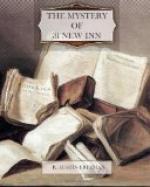“The importance of this conclusion emerges when we consider the exceptional character of Mr. Weiss’s spectacles. They were not merely peculiar or remarkable; they were probably unique. It is exceedingly likely that there is not in the entire world another similar pair of spectacles. Whence the finding of these fragments of glass in the bedroom establishes a considerable probability that Mr. Weiss was, at some time, in the chambers at New Inn.
“And now let us gather up the threads of this part of the argument. We are inquiring into the identity of the man Weiss. Who was he?
“In the first place, we find him committing a secret crime from which John Blackmore alone will benefit. This suggests the prima-facie probability that he was John Blackmore.
“Then we find that he was a man of normal eyesight who was wearing spectacles for the purpose of disguise. But the tenant of New Inn, whom we have seen to be, almost certainly, John Blackmore—and whom we will, for the present, assume to have been John Blackmore—was a man with normal eyesight who wore spectacles for disguise.
“John Blackmore did not reside at New Inn, but at some place within easy reach of it. But Weiss resided at a place within easy reach of New Inn.
“John Blackmore must have had possession and control of the person of Jeffrey. But Weiss had possession and control of the person of Jeffrey.
“Weiss wore spectacles of a certain peculiar and probably unique character. But portions of such spectacles were found in the chambers at New Inn.
“The overwhelming probability, therefore, is that Weiss and the tenant of New Inn were one and the same person; and that that person was John Blackmore.”
“That,” said Mr. Winwood, “is a very plausible argument. But, you observe, sir, that it contains an undistributed middle term.”
Thorndyke smiled genially. I think he forgave Winwood everything for that remark.
“You are quite right, sir,” he said. “It does. And, for that reason, the demonstration is not absolute. But we must not forget, what logicians seem occasionally to overlook: that the ‘undistributed middle,’ while it interferes with absolute proof, may be quite consistent with a degree of probability that approaches very near to certainty. Both the Bertillon system and the English fingerprint system involve a process of reasoning in which the middle term is undistributed. But the great probabilities are accepted in practice as equivalent to certainties.”




